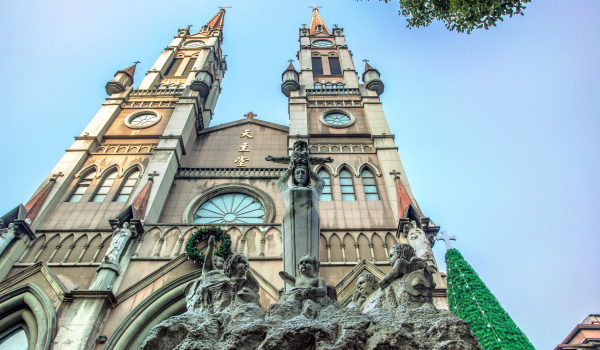
Ningbo Diocese covers the three cities of Ningbo, Shaoxing and Zhoushan at the northeastern part of Zhejiang province, with a territorial area of 19,513 square kilometer. The coastal cities are located next to the East Sea and are at the southeastern part of the Yangtze Delta.
There are 5.7 million people living in the sub-provincial city of Ningbo and 4.4 million in the prefectural city of Shaoxing. The population in Zhoushan, which is comprised of over a thousand of outlying islands, is only 373,000.
Besides official Mandarin, the dialects of Ningbo and Shaoxing were used in daily conversation in the respective cities among the older generation.To revive the local dialects, local TV and radio stations launch programs in the dialect.
The Catholic presence at Ningbo can be dated back to the Ming Dynasty when information shows that several churches built on the outlying Shuangyu Islands, probably by the Portguese, were demolished in 1548.
The names of first two missioners in record are Spanish Jesuit Father Rodrigo de Figueredo, arriving at Ningbo from Hangzhou in 1628, and Italian Jesuit Father Joannes Monteiro arriving in 1640.
In 1846, the Vicariate of Zhejiang, which covered the whole province, was established and entrusted to the French Congregation of Mission. When the vicariate was divided into two in 1910, Bishop Paul Marie Reynased was appointed the vicar of the Eastern Zhejiang vicariate, which was renamed the Vicariate of Ningbo in 1924.
Ningbo was elevated to a diocese when the hierarchy was established in 1946, covering Ningbo, Zhoushan, Shaoxing and Wenzhou. When Wenzhou was carved out and became a diocese 1949, Ningbo had a Catholic population of around 17,000.
Religious activity was halted during the Cultural Revolution (1966-1976). The Church in Ningbo revived in 1979. When Father Michael He Jinmin (later bishop) was appointed as the diocesan administrator in 1985, there were only 4 elderly priests serving 9,000 Catholics.
The diocese grows steadily. The latest statistics shows that in 2009, there were 24 young priests and 26 nuns serving 25,000 Catholic in 88 churches.
Back in history, Ningbo was one of the most important ports of the maritime Silk Road. Foreign trade took place as early as in the Tang dynasty (AD 618-907). The Chinese government turned Ningbo and Zhoushan ports from a shelter port and fishery port into a trade port.
Completed in 2009, the Ningbo-Zhoushan Expressway, which includes a 48-km long network of cross-sea bridges, connects the outlying Zhoushan and the mainland Ningbo, enhances the logistic network.
The freight handling capacity of Zhoushan port superseded Shanghai and topped the list in China and in the world in 2010.
Ningbo has a subtropical monsoon climate and is usually warm and humid. The four seasons are distinctive with summer and winter longer than spring and autumn. The average temperature in summer is 22 degrees Celsius and in winter 10 degrees. It has a crop-growing period of 300 days a year and the annual precipitation is 1480mm.
Sun Yat-sen, called "Father of the Nation" in the Republic of China (ROC), once made a comment in 1916, saying that although Ningbo was made a free trade port after Guangdong, the market was more open than its counterpart in southern China. There are Ningbo natives doing business in every province in the country as well as in different countries in Europe. Their power and capability are on the top of the list.
Hong Kong broadcasting tycoon and philanthropist Run Run Shaw was born in Ningbo. Meanwhile, Tung Chee-hwa, before appointed the first Chief Executive of Hong Kong Special Administrative Region, took over his family business of the shipping magnate Tung Chao Yung, who founded the Orient Overseas Container Lines. They were both native to the city.
The University of Nottingham, Ningbo is run by the University of Nottingham (UK) with a local Zhejiang education group. It was the first Sino-foreign tertiary institute to open in China in 2004, with approval from the Ministry of Education. It offers degree programs from the British university.
Ningbo is also the city which produces the highest number of academicians of the 2 national academies in China, namely the Chinese Academy of Sciences and the Chinese Academy of Engineering.
The Hemudu site, just 22 kilometers northwest of Ningbo city, was discovered in 1973. The Neolithic Hemudu culture, dated back to 5000 BC to 4500 BC, became an important archeological study in China in the 20th century. It proved that the Chinese civilization was bred not only along the Yellow River as believed, but also at this downstream of the Yangtze River. The wooden boat paddle and seeds of paddy rice found at the site gave prove to the presence of sea trade and agricultural advancement.
Ningbo was the birth-place of Chiang Kai-shek and his son Chiang Ching-kuo, political leaders of the Kuomindong and respectively the first and the second president of the Republic of China. (Taiwan).